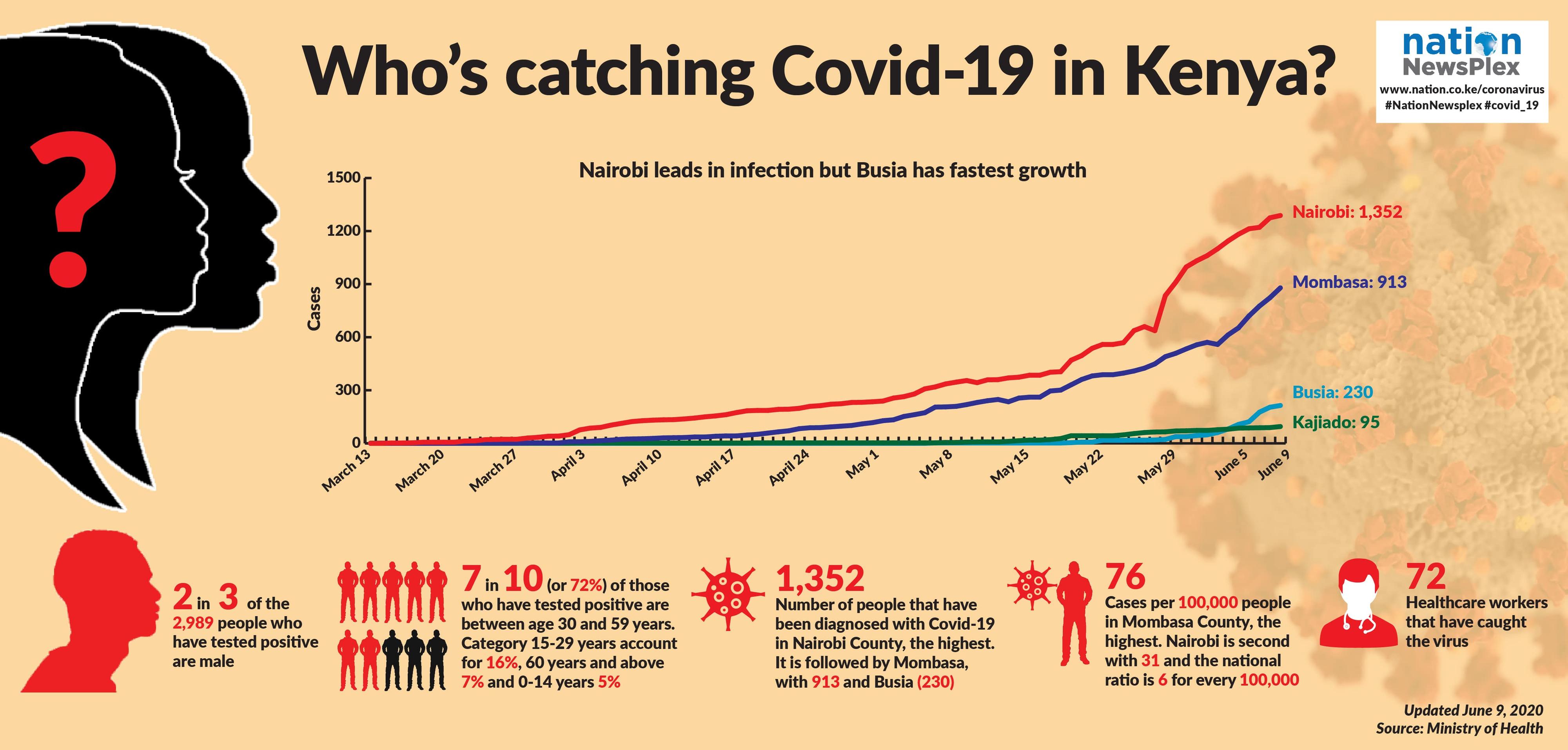Premium
Doctors not held to account for causing preventable injuries and deaths
DESIGN | MICHAEL MOSOTA
Given the frequent media reports of serious injury and deaths of patients caused by negligent health providers, Kenyans may be surprised to learn that only one doctor has been deregistered by the medical board in the past two decades.
Data from the Kenya Medical Practitioners and Dentists Board (KPMDB) shows that four doctors had their licences cancelled while six had theirs suspended for a period of six to 12 months for misconduct over the same period.
But a majority walked away with a slap on the wrist with 16 being sent for supervised training for a period of six to 12 months while 106 were ordered to go through continuous professional development.
Other sanctions included referrals to mediation or alternative dispute resolution (141), admonishment of medical or dental practitioners or health facilities (105) and directives to pay part of the cost of the board hearings (51).
While some medics have been found guilty by courts of law over the years, they continue practising with the Board failing to act — or having absolved some of them of blame.
From 1997 to March this year, 985 cases were lodged with the board. Of these, 70 cases are pending and 915 have been determined. About 97 per cent of them were resolved at the preliminary inquiry committee, two per cent at the national tribunal and two per cent at the national professional conduct committee.
“These are cases pending at various stages of investigations,” notes the board’s report.
The complaints peaked in 2008, when 85 cases were filed.
According to the board, 51 of the reported cases reported arose from other issues such as doctors failing to give medical reports, medics’ attitudes towards patients, sexual harassment as well as absconding duty. About third (29 per cent) of health providers in public facilities were found to be absent, compared to a fifth (21 per cent) in private facilities, according to a recent World Bank study on Service Delivery Indicators.
Public providers followed less than half (44 per cent) of the correct treatment actions needed for managing maternal and neonatal complications, according the World Bank study
Several studies on the competency of health providers suggest that the complaints received by the board could be the tip of the iceberg. Public providers followed less than half (44 per cent) of the correct treatment actions needed for managing maternal and neonatal complications, according the World Bank study
Figures from the study show that only 58 per cent of public health providers could correctly diagnose at least four out of five very common conditions, such diarrhoea with dehydration and malaria with anaemia.
The findings were affirmed in The First Confidential Enquiry into Maternal Deaths in Kenya released recently that identified one or more health worker-related factors in three-quarters of the maternal deaths in hospitals. The most frequent issues identified included: delaying starting treatment (a third); inadequate clinical skills (28 per cent); insufficient monitoring (27 per cent); prolonged abnormal observation without action (24 per cent); and incomplete initial assessment (23 per cent). Others were wrong diagnosis, wrong treatment and no treatment.
A Nation Newsplex review of stories in mainstream media about major medical misconduct that resulted in death or injury of patients in the past six months finds that incidents occurred in all categories of facilities (private, public and faith-based) and affected men and women across different ages. The review compiled seven cases, of which four happened in public health facilities, two in private institutions and one in a faith-based organisation. In more than half the cases the patients died.
Of the reports gathered, the eldest victim was Philip Muraya, 71, whereas the youngest was 20-day-old Joseph Ngugi. Mr Muraya succumbed to a brain injury at Nairobi Women’s Hospital that he sustained in a motorcycle accident in Kandara constituency, Kiambu County. He had fractured his hand and skull in the crash but doctors operated on his hand and ignored his head despite the CT scan results that showed he had a skull injury. The hospital slapped his widow with a Sh1.4 million medical bill when he died.
Ngugi was erroneously pronounced dead by doctors, only for him to wake up minutes before being buried by the family. He died hours later at Gatundu Level Five Hospital.
The compilation of medical incompetence and negligence cases varied from a botched caesarean section to a failed kidney transplant, a misdiagnosis, a dental operation gone wrong and a fatal breast-enhancement procedure. Nairobi had four reported cases, followed by Laikipia, Embu and Kiambu, each with one.
Two of the cases happened at Kenyatta National Hospital, the largest referral hospital in East and Central Africa. One of the cases that will live in Kenyans’ memory for a long time to come is where two men wheeled into KNH got mixed-up during surgery, leading the neurosurgeon to open up the head of the wrong patient. Four months ago, the patients both had concussion in which one needed head surgery to remove a blood clot in his brain while the other only required nursing and medication to heal a trauma swelling in his head.
However, the manner in which the error occurred and was handled by Kenyatta National Hospital left a lot to learn. Before news of the mix-up became public, the hospital had launched an investigation to know what went wrong.
But KNH did not admit the error nor apologise. Not until the Hospital’s top managers were summoned before the National Assembly’s Health Committee.
The hospital picked up the tab for the entire hospital stay for both patients, including the costs of the surgery during which the mistake occurred.
The hospital went one step further to reinforce protocol that the hospital was not following.
Barely three weeks before the dust could settle on the breaking news another one surfaced. Susan Nekesa, complained that a surgeon who opened her abdomen to retrieve her distressed baby during a caesarean section also nicked a section of her gut, resulting in complications.
Embu Level Five Hospital had one reported incident of a failed kidney transplant, leading to the death of Mr Anthony Njiru, a 39-year-old teacher. Mr Njiru’s case is a reminder of how much quality health service is still largely for the financially able.
His family had considered taking him to India, but failed to do so due to insufficient funds. He ended up at Embu Hospital and underwent the first kidney transplant ever carried out at the hospital.
A breast-enhancement procedure on June Wanza, 35, at a clinic in Karen turned fatal when she succumbed to an internal infection after her small intestines were cut. KMPDB promised to have the case investigated once an official complaint from the bereaved family is submitted.
The board’s figures show that about a quarter of the cases filed are connected to obstetrics and gynaecology, the largest proportion. It is followed by internal medicine (16 per cent), surgery (14 per cent) and financial (10 per cent). Paediatrics and orthopaedics each accounted for nine per cent.
Court cases
Cases that are forwarded to the courts usually attract the most attention. Early in March this year, the Bungoma High Court ruled on a case filed by Josephine Majani, who in 2013 was forced to give birth on the floor of the Bungoma County Referral Hospital delivery room because all the beds were occupied. The midwives and nurses were angered by this, repeatedly insulting and slapping her for “dirtying” the floor. The court ordered the county government to pay her Sh2.5 million.
Ms Majani is lucky to be alive. The confidential study by the Ministry of Health found that four in five expectant and new mothers who die in hospital receive poor care where a different management could have saved their lives or that of their child.
In another case, a Makueni Magistrates’ Court ordered Makindu Hospital to pay Sh6 million to baby Maweu Mutuku, whose leg was amputated after a light bulb fell on it moments after he was born and burnt it.
Infrastructure and equipment challenges also contribute to medical malpractices.
According to the World Bank, one in four public health facilities does not have the minimum required equipment, such as a weighing scale, a stethoscope, a sphygmomanometer and a thermometer. And one in five health facilities lacks access to clean water.






